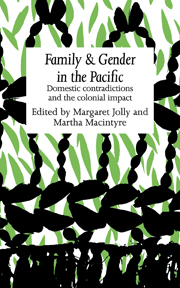Book contents
- Frontmatter
- Contents
- List of contributors
- Acknowledgements
- Map of main island groups of the Pacific
- Map of Papua New Guinea – Provinces
- Introduction
- 1 New England missionary wives, Hawaiian women and ‘The Cult of True Womanhood’
- 2 Changes in the lives of ordinary women in early post-contact Hawaii
- 3 Domestic structures and polyandry in the Marquesas Islands
- 4 The object lesson of a civilised, Christian home
- 5 Medical care and gender in Papua New Guinea
- 6 Suffer the children: Wesleyans in the D'Entrecasteaux
- 7 Women in contemporary Central Enga society, Papua New Guinea
- 8 Better homes and gardens
- 9 God, ghosts and people: Christianity and social organisation among Takuru Wiru
- 10 Sins of a mission: Christian life as Kwaio traditionalist ideology
- 11 Sacred spaces: churches, men's houses and households in South Pentecost, Vanuatu
- 12 Bond-slaves of Satan: Aboriginal women and the missionary dilemma
- Bibliography
- Index
9 - God, ghosts and people: Christianity and social organisation among Takuru Wiru
Published online by Cambridge University Press: 05 November 2011
- Frontmatter
- Contents
- List of contributors
- Acknowledgements
- Map of main island groups of the Pacific
- Map of Papua New Guinea – Provinces
- Introduction
- 1 New England missionary wives, Hawaiian women and ‘The Cult of True Womanhood’
- 2 Changes in the lives of ordinary women in early post-contact Hawaii
- 3 Domestic structures and polyandry in the Marquesas Islands
- 4 The object lesson of a civilised, Christian home
- 5 Medical care and gender in Papua New Guinea
- 6 Suffer the children: Wesleyans in the D'Entrecasteaux
- 7 Women in contemporary Central Enga society, Papua New Guinea
- 8 Better homes and gardens
- 9 God, ghosts and people: Christianity and social organisation among Takuru Wiru
- 10 Sins of a mission: Christian life as Kwaio traditionalist ideology
- 11 Sacred spaces: churches, men's houses and households in South Pentecost, Vanuatu
- 12 Bond-slaves of Satan: Aboriginal women and the missionary dilemma
- Bibliography
- Index
Summary
In August 1961 a patrol post was established to administer the Wiru-speaking people of what later became Pangia district, in the Southern Highlands Province of Papua New Guinea (Figure 9.1). The location and geographic features of the district, which prior to pacification resulted in the area becoming a trade ‘backwater’ (Strathern 1968:551), conspired to make Pangia one of the last Southern Highlands regions with large populations to be colonised. The timing of derestriction meant that missions were well organised and enthusiastic about bringing Christianity to the ‘black, savage, heathen New Guineans’ (Bustin n.d.:53).
The colonial experience of Wiru was of a different order from that of most other highlanders. Pangia was inundated by missions in the years following its derestriction – not only were the mainline missions (Catholic and Lutheran) represented, but also numerous fundamentalist and evangelical groups and sects. The district was well covered by missionaries and native evangelists, and Wiru readily accepted the new religion for much the same reasons as they adopted cults in the pre-pacification era (see Clark 1985). At the same time, Wiru faced a concerted development programme initiated by the Australian Administration, and experienced pressure from both missionaries and ‘kiaps’ to change many of their practices and beliefs in an effort to convert them into Christian peasants.
What follows is a consideration of the impact of Christianity based on field work conducted in the Wiru settlement of Takuru.
- Type
- Chapter
- Information
- Family and Gender in the PacificDomestic Contradictions and the Colonial Impact, pp. 170 - 192Publisher: Cambridge University PressPrint publication year: 1989
- 1
- Cited by



